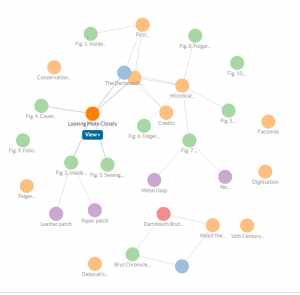Our wonderful Post-Bac Fellow, Bay, left us for another fellowship at the end of June. Her projects with Remix explored digital publishing in widely available platforms (check out what she made on Shared Shelf and Omeka). Bay began to explore using Scalar, but ran into some issues with the interoperability of the platform with Shared Shelf, where we had chosen to host the images for the digital book she was creating. Here are Bay’s reflections on using Scalar:
Scalar is a media-based digital publishing platform that allows users to direct their own experience of the media collection. Essentially, you can set up pages in paths like a normal e-book, directing readers through the material in a set fashion — but at any point, readers can use visualizations to examine the media, pages, and paths as they choose. This is what I came to the digital for: an experience totally unlike a book that allowed the user/reader to navigate the landscape independently.
Unlike with Omeka’s defined structure, Scalar lets the author control the book’s organization. Authors choose which items appear on which path and what relationships to create and foreground, while readers can follow author-defined paths or their own.
Bay learned that while Scalar is theoretically interoperable with any media source on the internet, our images, as they were hosted in Shared Shelf and Omeka.net, were not available for her project, since both platforms wrap images in a viewer, instead of generating a stable URL for the item. At the time, it did not seem that we could harvest stable URLs from within Shared Shelf. We thought we were at an impasse, until I had an opportunity to work with Curtis Fletcher, who is one of the lead project managers for Scalar at USC’s Alliance for Networking Visual Culture. In working with Curtis to follow up on Bay’s original project, we learned that uploading each image as a “local media file” in our Scalar book was the best way to proceed. (Later, we found the hack for URLs that link directly to the images in Shared Shelf, but that is a topic for another day.)
At the risk of burying the lead, here is our Scalar book: The Dartmouth Brut: Conservation, Authenticity, Dissemination. So far, we have mocked up three pages. We need more time with the platform to develop a strategy that will take full advantage of the relational capabilities and realize the potential that Bay was looking for. At this point, the prototype looks fairly similar to the Omeka exhibit.
For me, as Dartmouth’s Digital Humanities Librarian, what was most interesting about using Scalar was the context in which I met Curtis, at a meeting of the Digital Liberal Arts Exchange (DLAx) at Middlebury College. The intent of DLAx is to exchange services for digital scholarship among practitioners and scholars at different institutions. Even at Dartmouth, which has the size and undergraduate focus of a liberal-arts college but the scholarly ambition of a research university, we don’t always have access to the support and collaboration that our digital projects need. DLAx could provide an arena for Remix to find consultation and advice while also giving us an opportunity to share our experience and growing expertise. Having a half-day consultation with Curtis was enough time and attention to foment a breakthrough towards ideating the Scalar book. Sometimes the impetus a project needs in order to move forward is just a little bit of focused attention. We look forward to further iterations.
How can visualizations lead to new analysis? (snippet from our Scalar book)

